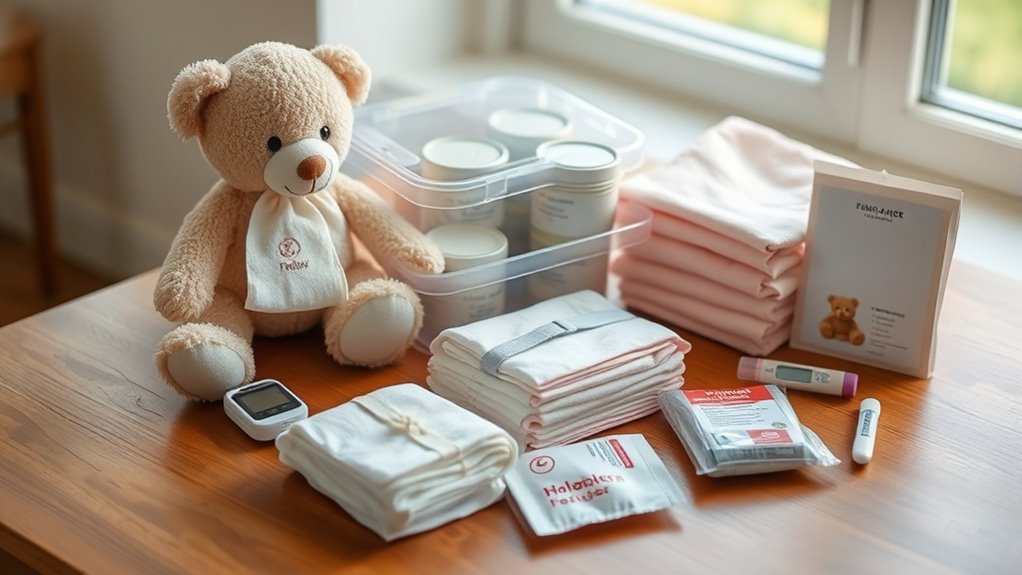To prepare for emergencies with an infant, create a tailored kit with formula, diapers, wipes, and comfort items. Secure your home by eliminating hazards and practicing safe evacuation routes. Keep emergency contacts, medical records, and a charged phone nearby. Maintain routines and monitor your baby’s well-being during storms or disasters. Regularly update your plans and safety measures to guarantee readiness. Continue exploring for detailed steps to keep your family and infant safe.
Key Takeaways
- Prepare an infant-specific emergency kit with formula, diapers, comfort items, medications, and basic first aid supplies.
- Secure your home environment by anchoring furniture, covering sharp edges, and removing hazards from reach.
- Create and practice safe evacuation routes and identify a designated safe gathering spot for the family and infant.
- Maintain updated emergency contacts, carry important documents, and ensure communication plans are clear and accessible.
- Keep routines consistent, include familiar comfort items, and monitor your infant’s well-being during emergencies.

Preparing for emergencies is especially essential when you have an infant to protect. Their safety depends on your ability to anticipate potential hazards and create a solid plan. When it comes to disaster planning, you need to think beyond just basic supplies and consider how to keep your baby safe during a crisis. Your first step should be to assemble an emergency kit tailored specifically for infants. Pack enough formula, baby food, bottles, and snacks to last several days. Don’t forget diapers, wipes, and changing supplies, as well as a favorite blanket or stuffed animal to provide comfort. Include any medications your infant needs, along with a thermometer and basic first aid supplies.
Assemble an infant-specific emergency kit with essentials and comfort items to ensure safety during a crisis.
Incorporate infant safety into your disaster planning by making sure your home environment is as secure as possible. Secure heavy furniture to walls and cover sharp edges to prevent injuries during tremors or chaos. Keep hazardous substances out of reach, and have a plan for safe evacuation routes that accommodate your baby’s needs. Practice these routes regularly so they become familiar, reducing panic during a real emergency. Also, identify a safe designated spot in your home where your family can gather if you need to shelter in place, and make sure it’s accessible for carrying an infant. Additionally, consider home safety assessments to identify and mitigate potential risks before an emergency occurs. Being aware of essential safety measures can further enhance your preparedness and help protect your infant from unforeseen dangers. Conducting a comprehensive safety audit can uncover vulnerabilities you might not have considered. Familiarize yourself with proper emergency procedures to ensure you respond swiftly and effectively during a crisis.
Communication is a key part of your disaster plan. Have a list of emergency contacts, including your pediatrician, local emergency services, and nearby relatives or friends who can assist if needed. Make sure your phone is always charged and consider having a portable charger on hand. Share your disaster plan with all family members and caregivers, so everyone knows their role. If you’re evacuated, take your infant’s medical records, vaccination history, and any essential documents in a waterproof container.
You also need to think about your infant’s comfort and routine disruptions. Keep familiar items like a favorite blanket, toy, or pacifier in your emergency kit. Stick to familiar feeding and sleeping routines as much as possible to reduce stress for your baby. During a disaster, monitor your infant closely for signs of distress or dehydration, and be prepared to adapt your plans as needed. Regularly review and update your emergency preparedness checklist to account for your baby’s changing needs and any new risks in your area. Understanding the importance of projector technology can help you create a calming, familiar environment if you choose to set up a home shelter or entertainment area during extended emergencies. Remember, thorough disaster planning and prioritizing infant safety can make all the difference in protecting your little one during unpredictable situations.
Frequently Asked Questions
How Often Should I Review and Update My Emergency Kit?
You should review and update your emergency kit at least every six months to guarantee kit maintenance and that supplies are in good condition. Regularly check expiration dates and replace used or expired items. Conduct emergency drills with your family to practice using your kit and identify any gaps. Keeping your kit current and practicing preparedness helps you feel confident and ready for any unexpected situation.
What Are the Best Ways to Communicate During an Emergency With Infants?
During an emergency, effective infant communication and emergency messaging are crucial. You should keep a calm, reassuring tone and use simple words or gestures to comfort your baby. Carry a portable device with preloaded emergency contacts and information. Practice emergency messaging with your family, ensuring everyone knows how to communicate clearly. Stay attentive to your infant’s cues, and use familiar routines to help them feel safe amidst the chaos.
How Can I Prepare for a Power Outage With an Infant?
Imagine a night turned gentle and calm, even when the power whispers away. You prepare by keeping battery-powered devices handy for warmth and comfort, ensuring your little one stays cozy. Emergency lighting, like flashlights or candles, helps you see clearly in the dark. Stock extra batteries, and keep a small, accessible kit ready, so you feel confident steering through any unexpected blackout while keeping your infant safe and comforted.
What Emergency Contact Information Should I Have Readily Available?
You should keep an up-to-date emergency contact list easily accessible. Include numbers for family members, neighbors, your child’s doctor, and local emergency services. Also, prepare your infant’s medical information, like allergies, medications, and immunization records. Having this info ready guarantees quick access during emergencies, helping you respond swiftly and keep your baby safe. Regularly review and update your contact list and medical details to stay prepared.
How Do I Handle Medication Needs for My Infant in a Disaster?
When it comes to handling your infant’s medication needs during a disaster, you don’t want to be caught with your pants down. Keep a portable emergency pharmacy stocked with essential infant medication, including prescriptions, pain relievers, and any special needs items. Store a supply of extra medication in a waterproof container, and don’t forget to include copies of prescriptions. Regularly check expiration dates so you’re prepared for anything that comes your way.
Conclusion
So, after all that planning, just remember: if disaster strikes, your tiny human will be counting on you to remember the diaper bag, a bottle, and maybe a little bit of luck. Because nothing says “prepared” like knowing you’ve got all the essentials—except maybe a miracle or two. Stay calm, stay ready, and hope your emergency kit doesn’t become a toddler’s new favorite toy. After all, who needs peace of mind when you’ve got a fully stocked bag?









